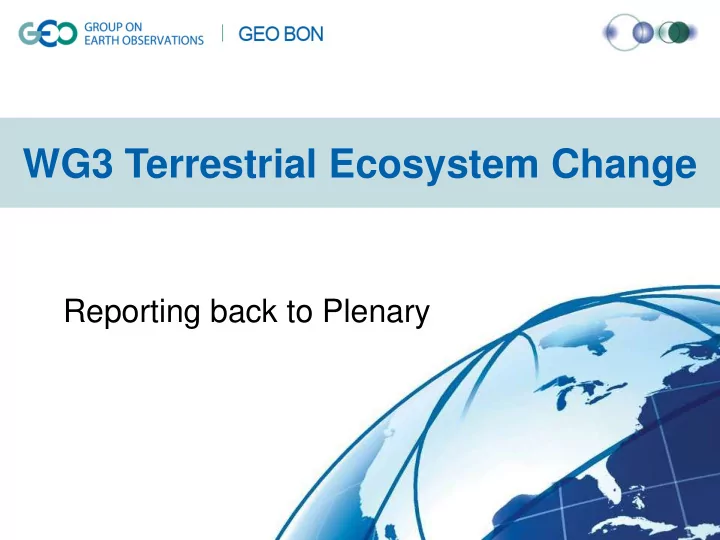

WG3 Terrestrial Ecosystem Change Reporting back to Plenary
Deliverable overview + responsible staff 1. Handbook Chapter 3 2. Field site network building – engagement of network – global network of field sites undertaking long- term co-located measurements on appropriate scales for linking drivers, states and impacts
Deliverable: Field Site Network Building Global Network of Biodiversity and Ecosystem Observation Sites field sites undertaking long-term co-located Build network measurements at appropriate scales for linking drivers, states and impacts community Site-metadatabase 2013 Linked-data based on EBVs e.g. on ecosystem services Proof of concept “Use Agriculture Water cases” and early products 2015 Analytical framework for landscape and wildlife tourism advanced “use cases” linking data, models and Forestry Soils / carbon stores RS: 2020 delivering to Aichi targets
Deliverable overview + responsible staff 3. Ecosystem elements & EBV – Methodological overview of EBVs as derived from EO data; map product of EO derived EBVs and plant functional traits at a global/regional scale – Examples of primary EBV produced through image processing include leaf nitrogen concentration, phenology, NPP, biomass, plant height, foliage canopy cover. Spatial resolution will be fine (25m) to moderate (250 m). Leaf nitrogen grasses • grasses
Deliverable overview + responsible staff 4. Global ecosystem mapping + stratification
Deliverable overview + responsible staff 5. Ecosystem restoration and degradation change – Regional to global spatial system for determining potential sites for restoring ecosystems and monitoring progress toward restoration – Demonstrate the potential of delivering the System for selected countries/regions (in Australia, Colombia, Brazil). – Maps of actual and potential ecosystem extent are required
Ecosystem restoration Areas suitable for restoration: b) a) Early regrowth, Brigalow Belt Bioregion, south east Queensland, a) Australia. (ALOS/Landsat integration, 2009) b) Degraded sites with different land use histories, Manaus, Brazil (Landsat time-series; 1972-2003)
Deliverable overview + responsible staff 6 . Links to other GEO groups (GEO-FCT etc) – GEOBON SC effort? – GEOSS scientific conference? 7. Capacity Building – 15-day workshop including training materials (manuals/ textbook with translations if applicable)
Coordinating Agencies • Handbook chapter Ecosystem Change (WUR) • Field site network building – engagement of network (CEH, Aberystwyth U, Humboldt) • Ecosystem elements & EBV (ITC, Aberystwyth U, Yokohama U, USGS, CSIRO, Humboldt, WUR, CEH) • Global ecosystem mapping + stratification (USGS, Edinburgh, WUR, UBC, CSIRO, Humbolbt, ITC) • Ecosystem restoration and degradation change (Aberystwyth U, CSIRO, Humboldt, ITC, Yokohama U, WUR) • Links to other GEO groups (GEO-FCT etc) (Aberystwyth U, CSIRO, CEH) • Capacity Building (Humbolt, ITC, Yokohama)
Aichi Targets X X X X X X X
Aichi Targets • Handbook chapter Ecosystem Change () • Field site network building – engagement of network (1,4,14,15) • Ecosystem elements & EBV (7,19) • Global ecosystem mapping + stratification (5, 11, 14) • Ecosystem restoration and degradation change (5,15) • Links to other GEO groups (GEO-FCT etc) • Capacity Building (19) • Also CBD, IPBES, Eye on Earth, …
2013 2014 2015 Handbook chapter on Ecosystem Change Field site directory network building Global Field Capacity ecosystem datasets building mapping Literatur e review EBVs EBV ecosyste Training map m map materials Ecosystem restoration and tools degradation change Coordination with other GEO BON WGs and other GEO groups
Links to other WGs and BONs 1. Handbook chapter Ecosystem Change (GEOBON) 2. Field site network building – engagement of network (WG2) 3. Ecosystem elements & EBV (WG2,WG6,WG7,WG8,WG9) 4. Global ecosystem mapping + stratification (GEOSS Ecosytems) 5. Ecosystem restoration and degradation change (WG7,GEO_GLAM,GFOI,WG9) 6. Links to other GEO groups (GEO-FCT,GFOI, GEO_GLAM, GEOSS Land Cover, GEOBON) 7. Capacity Building (GEOBON,RBON)
Funding 1. Handbook chapter Ecosystem Change (GEOBON) Field site network building – engagement of network (in-kind 2. contribution; workshop 50k) 3. Ecosystem elements & EBV (reviews & local prototypes in-kind; global products require funding) 4. Global ecosystem mapping + stratification (in-kind input data; 2 fte (USGS, NatureServe) + travel) 5. Ecosystem restoration and degradation change (in-kind development and case studies; funding for global implementation) 6. Links to other GEO groups (GEO-FCT etc) (meetings and travel 50k) 7. Capacity Building (workshop 50k) Cross-cutting the deliverables: Prospective
Challenges and Gaps 1. Field site network building – engagement of network (Timeline of verification data from 2 into 3-5) 2. Ecosystem elements & EBV (accuracy and retrieval, global implementation) 3. Ecosystem restoration and degradation change (global implementation, empirical and local knowledge required) 4. Links to other GEO groups (GEO-FCT etc) (GEOBON issue?) 5. Capacity Building (require input from 2-5; post 2015?)
Next steps • Timeline • Interim meeting (funding) • Prospective
Recommend
More recommend